Abstract
Although humans vary in their response to chemicals, comprehensive measures of susceptibility have generally not been incorporated into human risk assessment. The U.S. EPA dose-response-based risk assessments for cancer and the RfD/RfC (reference dose-reference concentration) approach for noncancer risk assessments are assumed to protect vulnerable human subgroups. However, these approaches generally rely on default assumptions and do not consider the specific biological basis for potential susceptibility to a given toxicant. In an effort to focus more explicitly on this issue, this article addresses biological factors that may affect human variability and susceptibility to trichloroethylene (TCE), a widely used halogenated industrial solvent. In response to Executive Order 13045, which requires federal agencies to make protection of children a high priority in implementing their policies and to take special risks to children into account when developing standards, this article examines factors that may affect risk of exposure to TCE in children. The influence of genetics, sex, altered health state, coexposure to alcohol, and enzyme induction on TCE toxicity are also examined.
Full text
PDF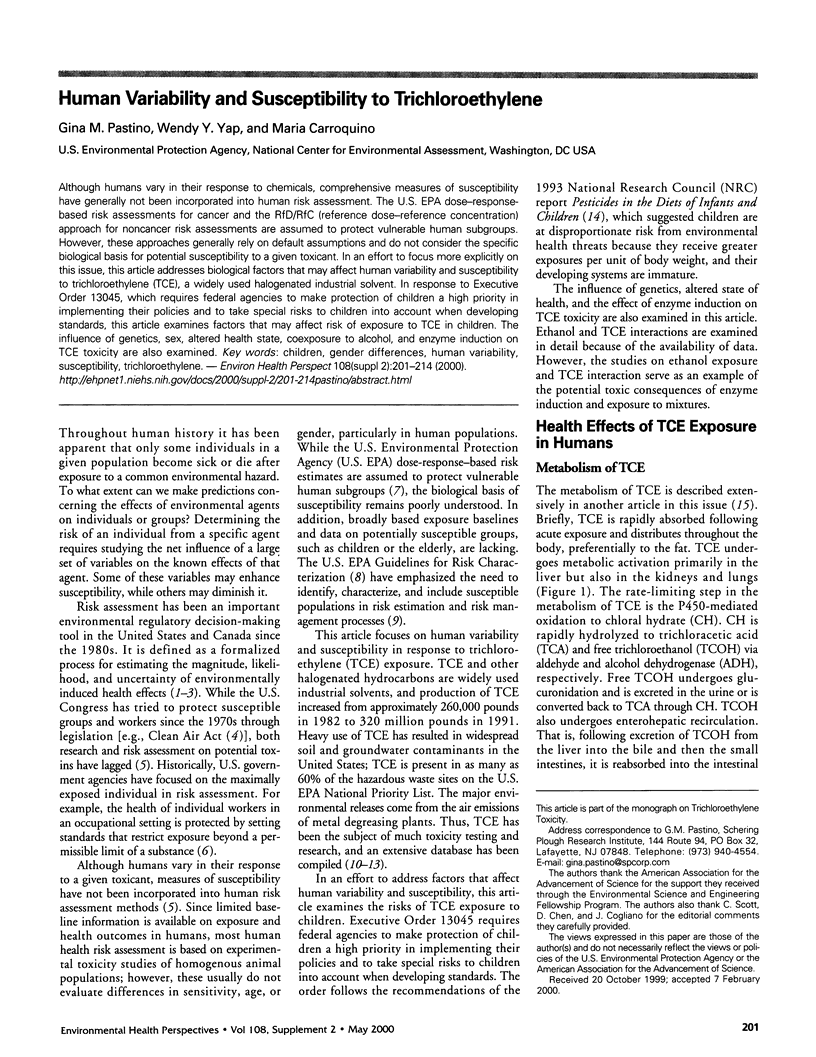
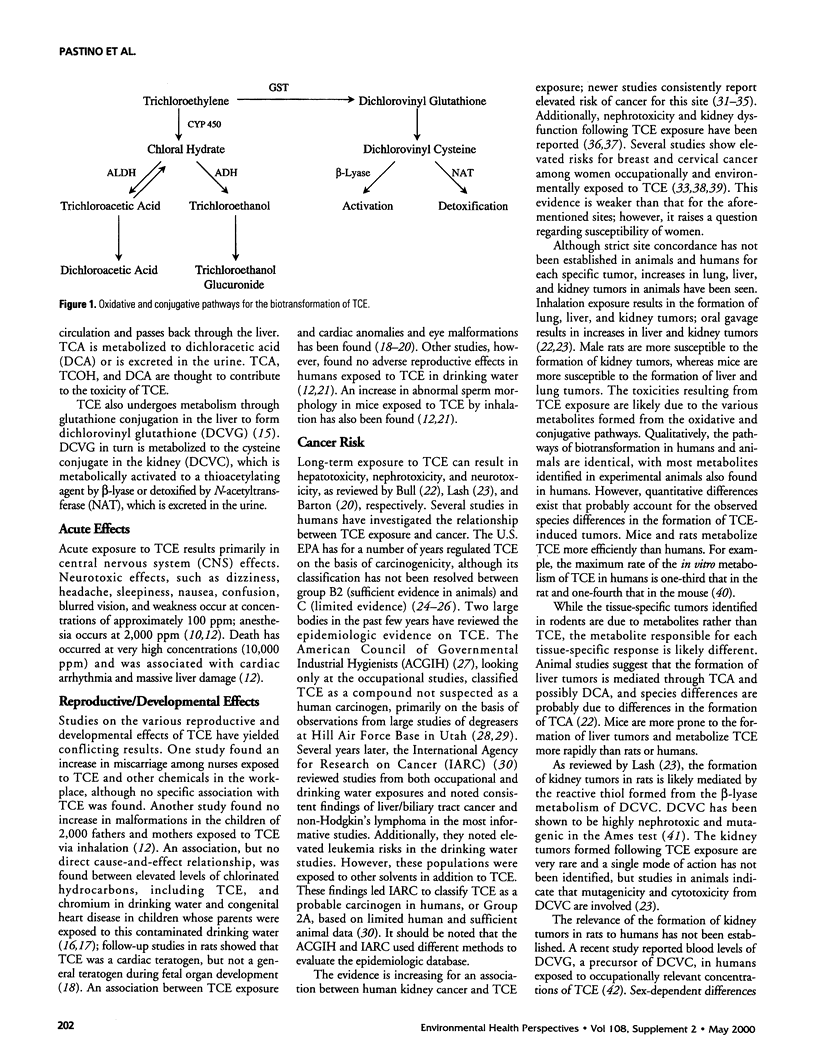
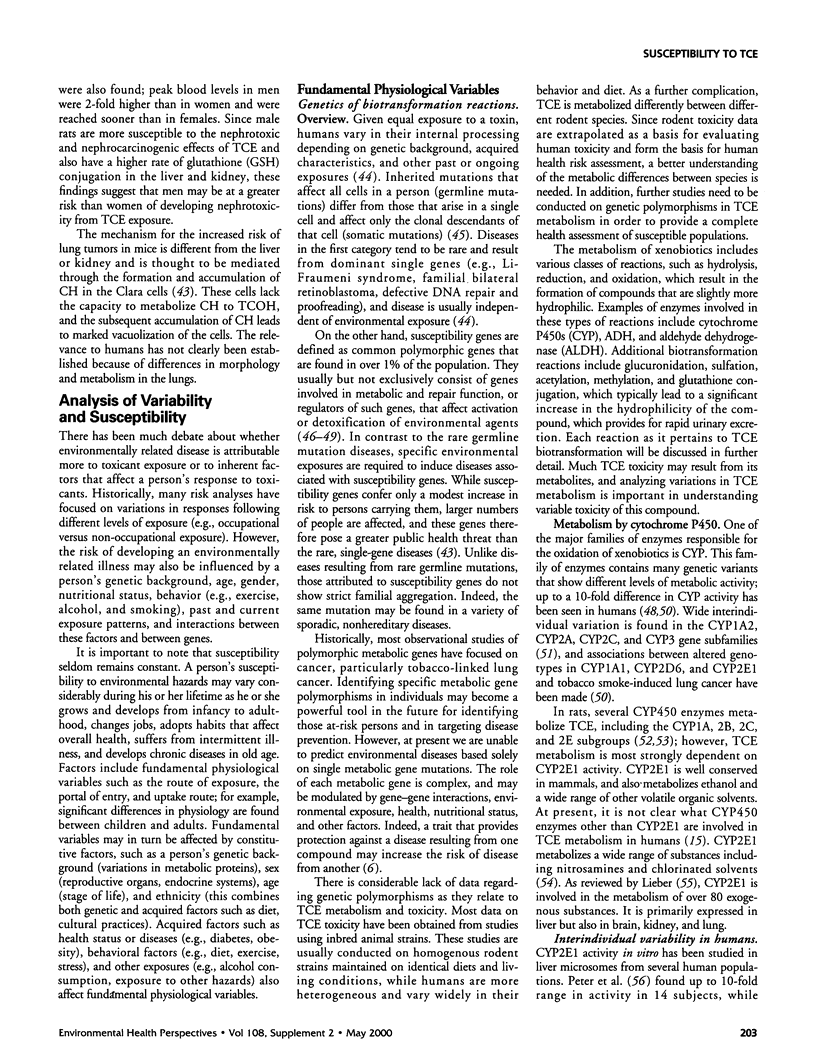
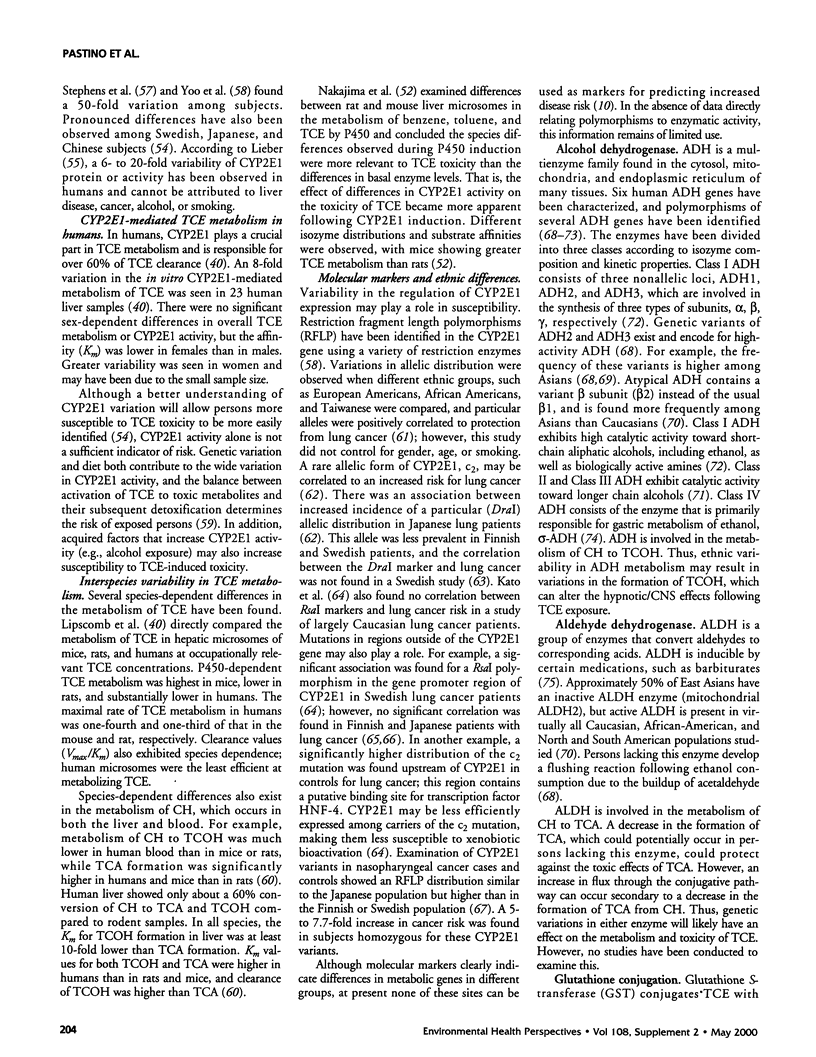
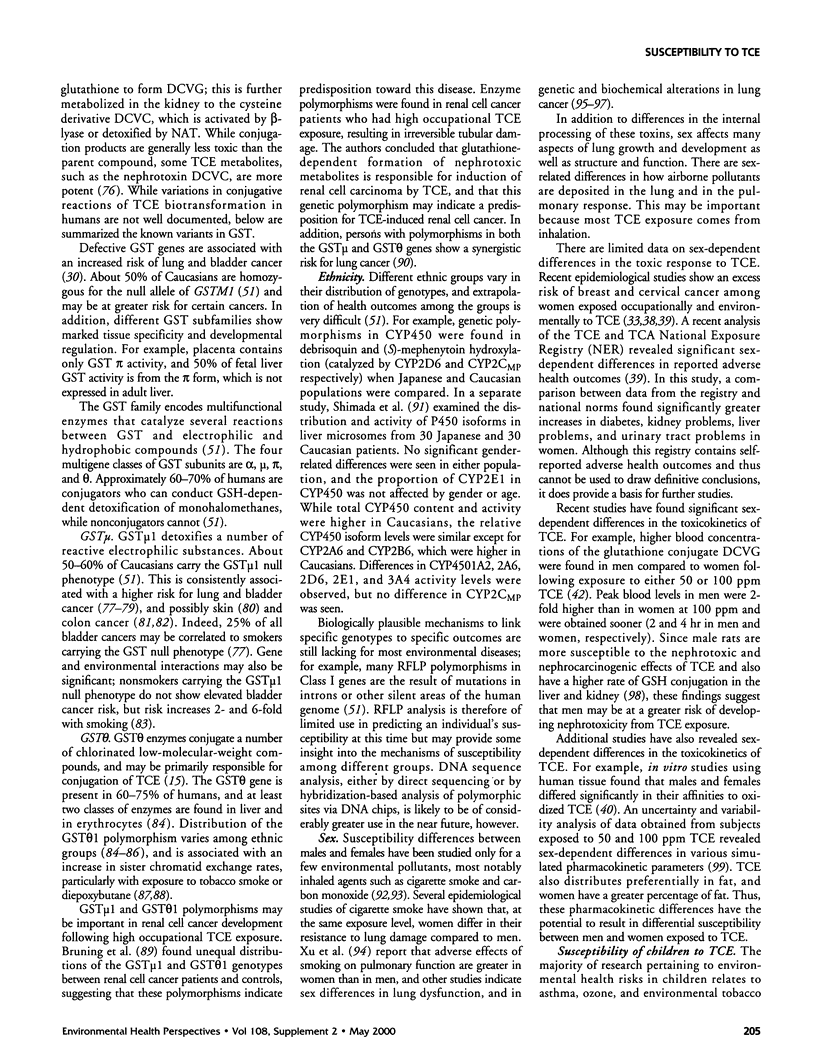
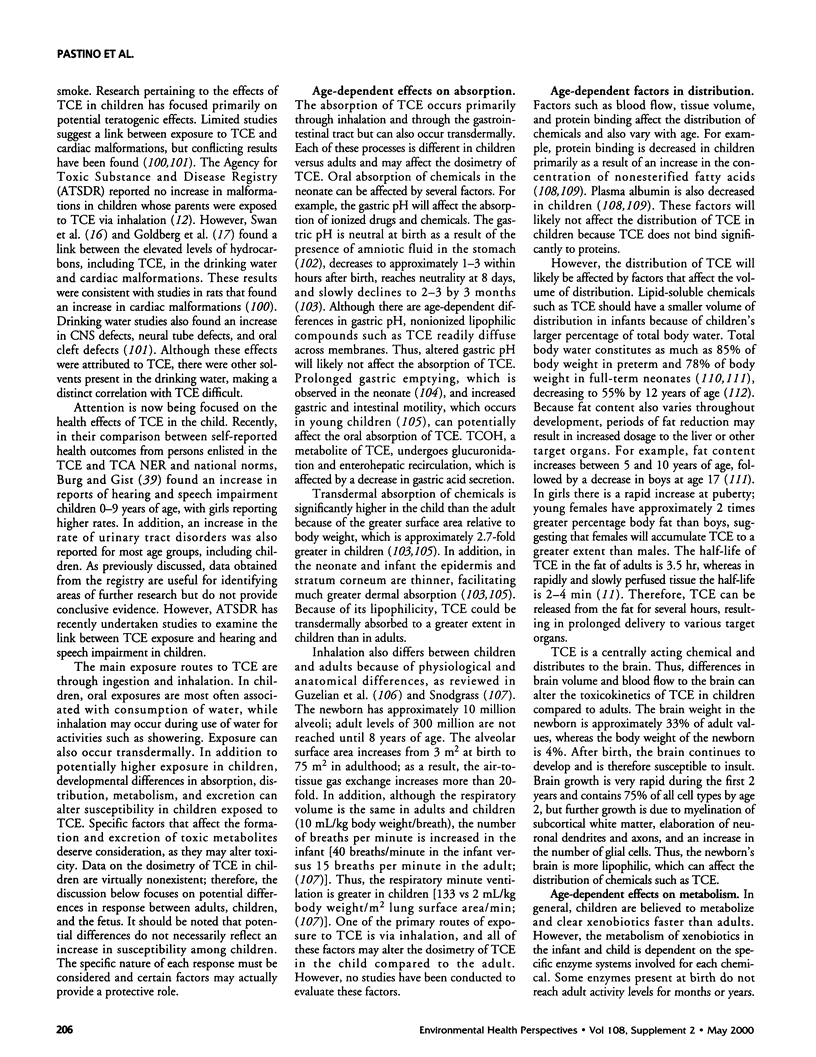
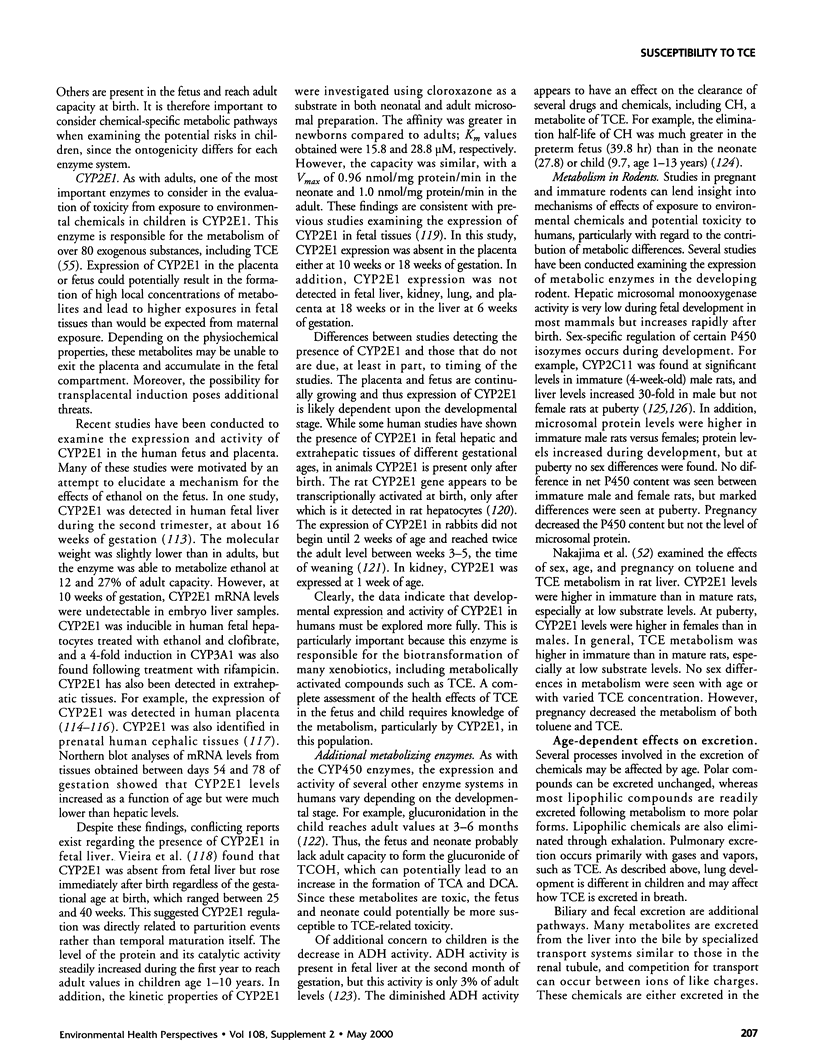
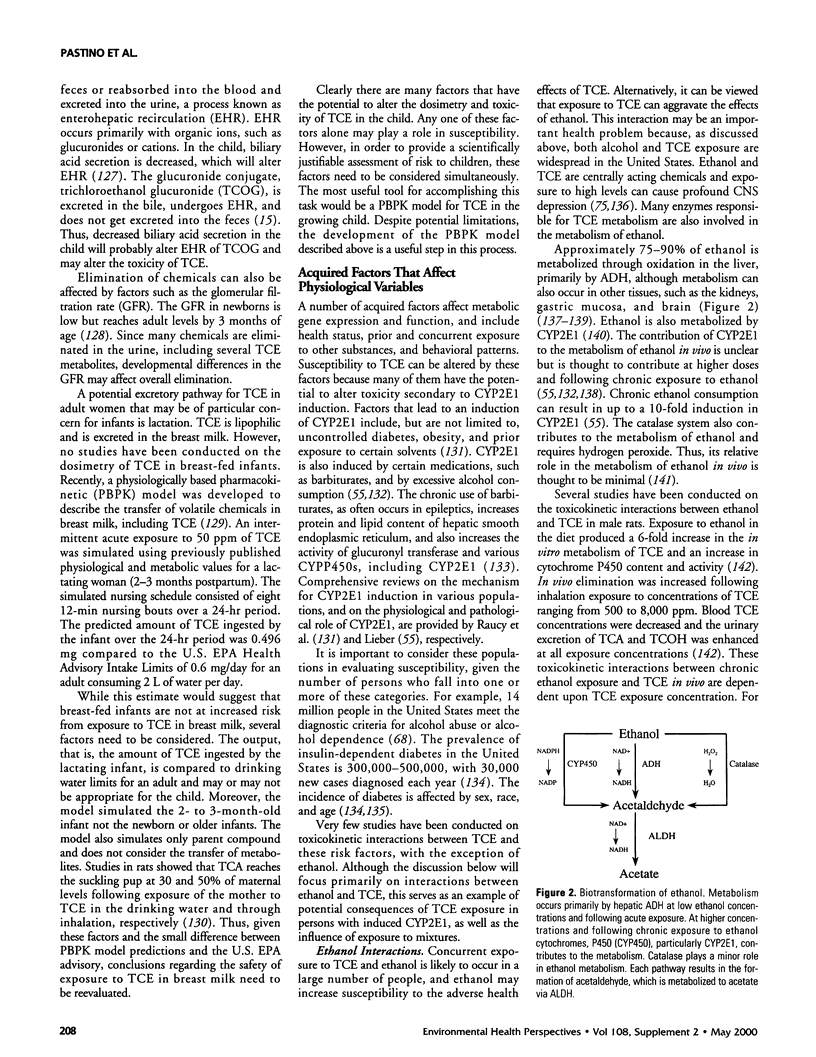
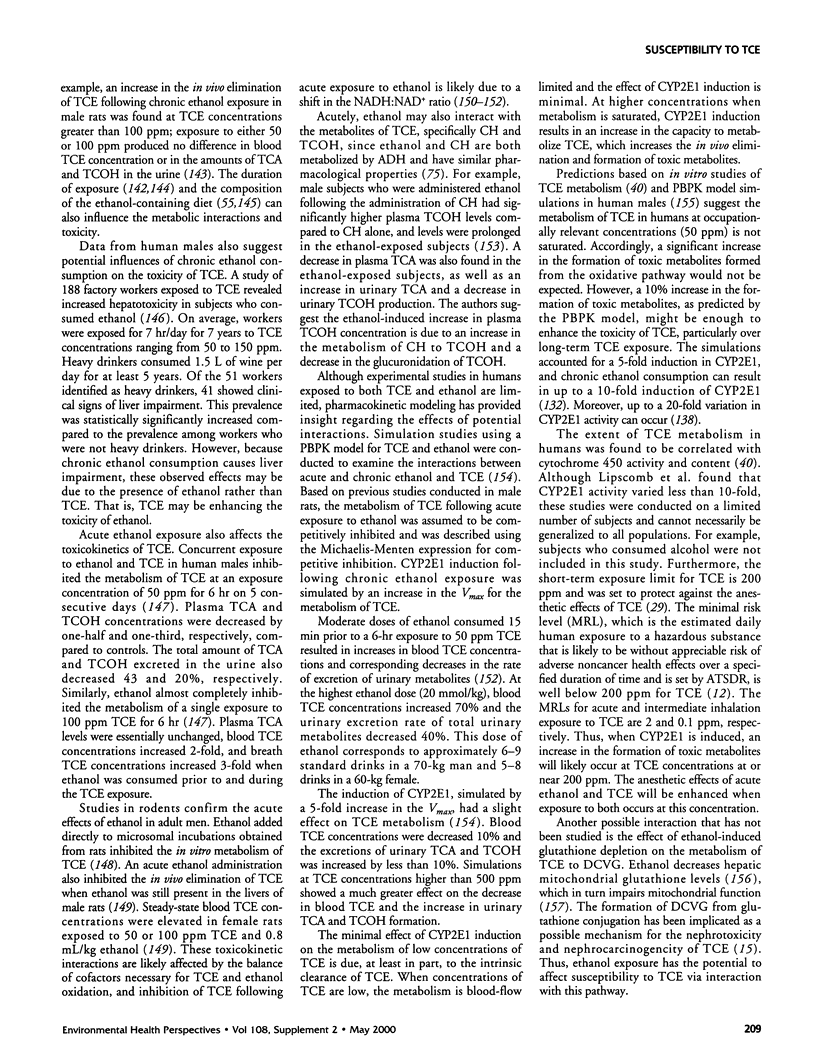
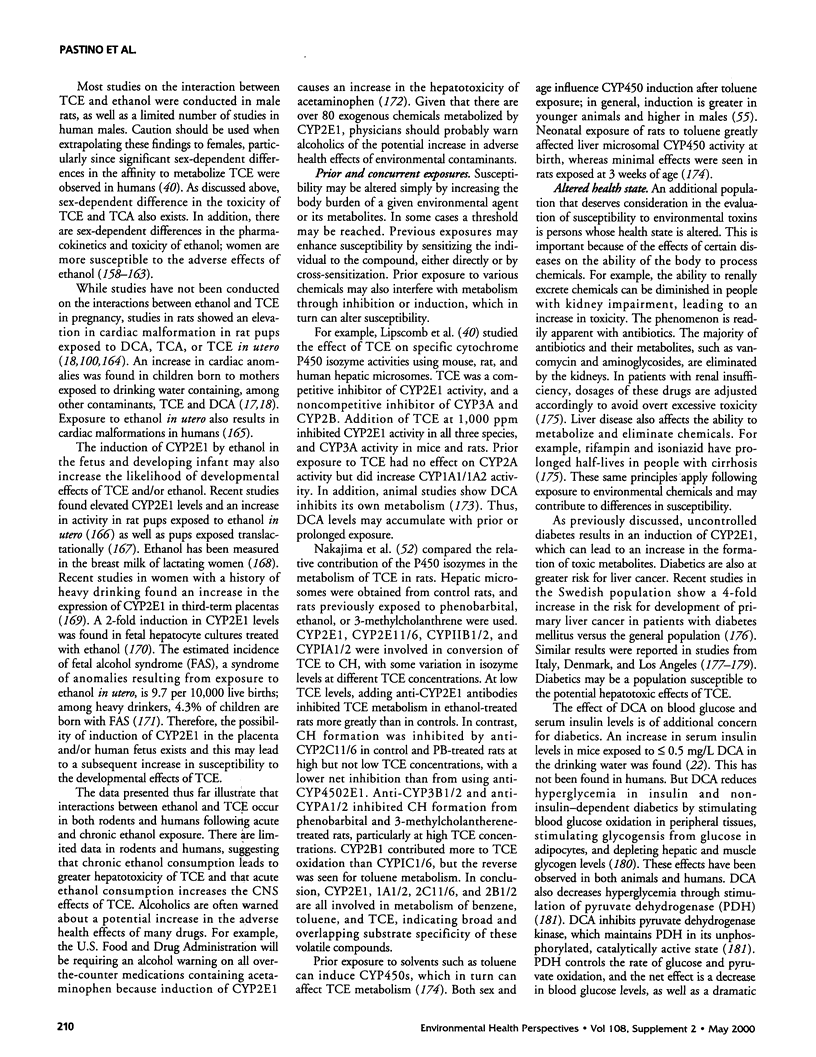
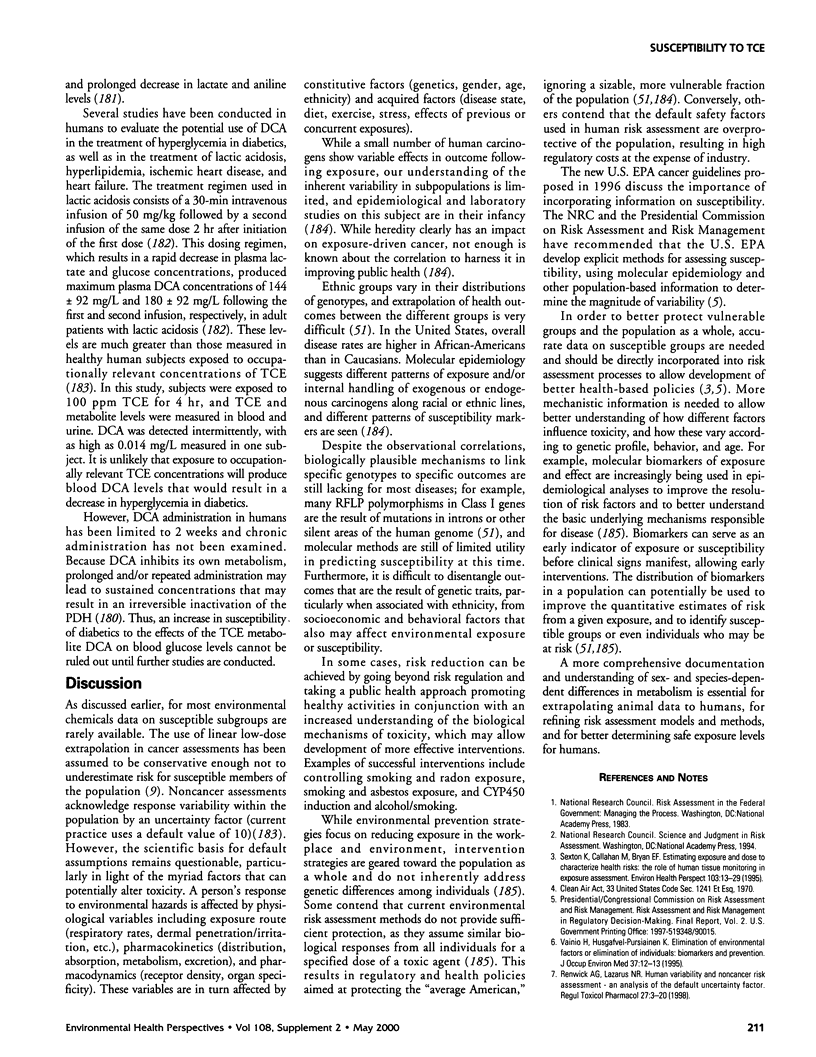
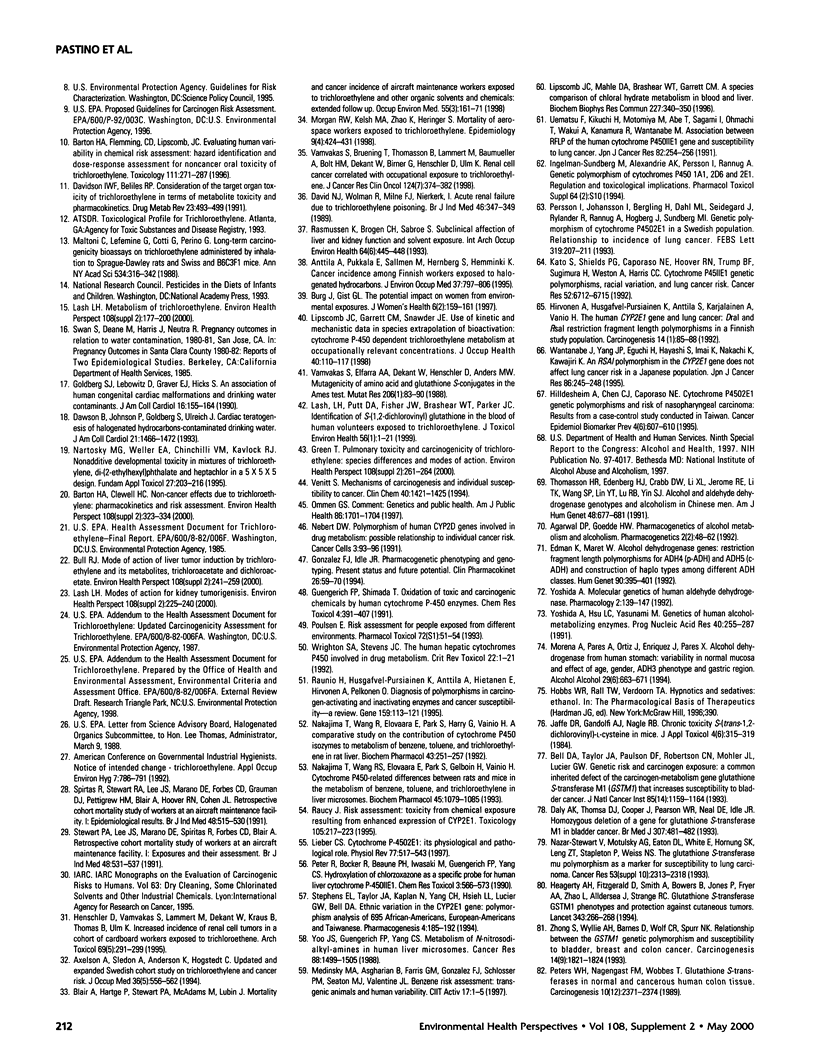
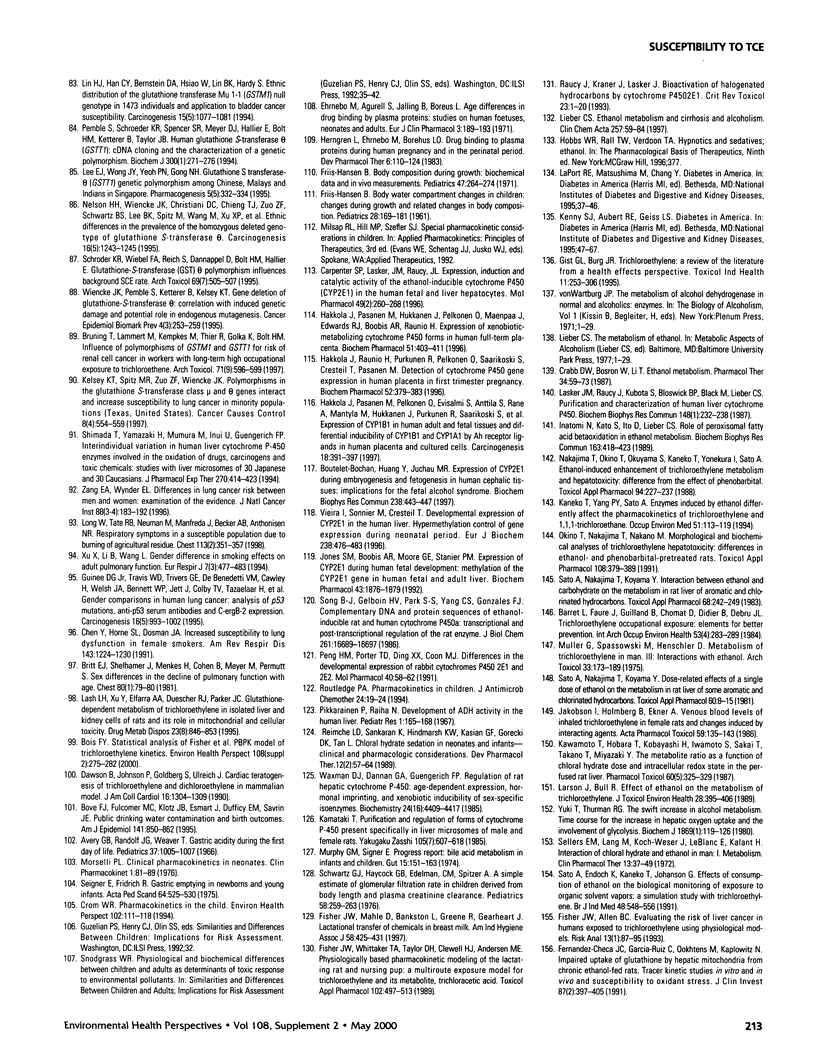
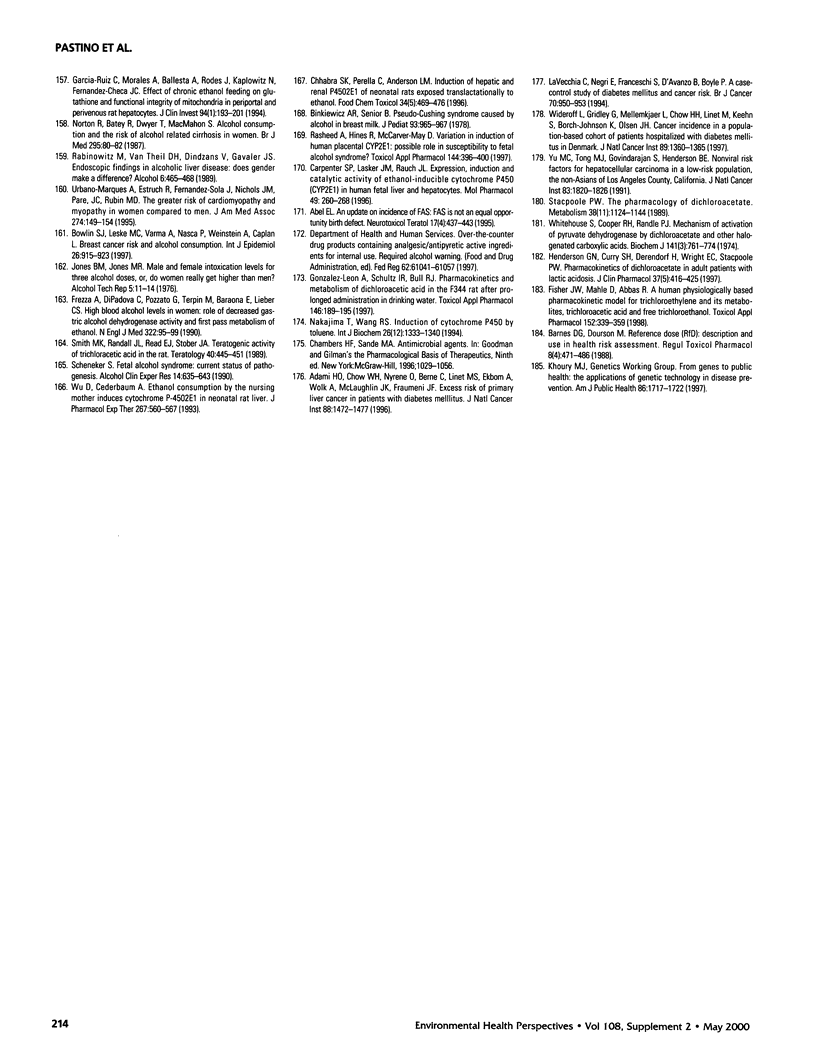
Selected References
These references are in PubMed. This may not be the complete list of references from this article.
- Abel E. L. An update on incidence of FAS: FAS is not an equal opportunity birth defect. Neurotoxicol Teratol. 1995 Jul-Aug;17(4):437–443. doi: 10.1016/0892-0362(95)00005-c. [DOI] [PubMed] [Google Scholar]
- Adami H. O., Chow W. H., Nyrén O., Berne C., Linet M. S., Ekbom A., Wolk A., McLaughlin J. K., Fraumeni J. F., Jr Excess risk of primary liver cancer in patients with diabetes mellitus. J Natl Cancer Inst. 1996 Oct 16;88(20):1472–1477. doi: 10.1093/jnci/88.20.1472. [DOI] [PubMed] [Google Scholar]
- Agarwal D. P., Goedde H. W. Pharmacogenetics of alcohol metabolism and alcoholism. Pharmacogenetics. 1992 Apr;2(2):48–62. doi: 10.1097/00008571-199204000-00002. [DOI] [PubMed] [Google Scholar]
- Anttila A., Pukkala E., Sallmén M., Hernberg S., Hemminki K. Cancer incidence among Finnish workers exposed to halogenated hydrocarbons. J Occup Environ Med. 1995 Jul;37(7):797–806. doi: 10.1097/00043764-199507000-00008. [DOI] [PubMed] [Google Scholar]
- Avery G. B., Randolph J. G., Weaver T. Gastric acidity in the first day of life. Pediatrics. 1966 Jun;37(6):1005–1007. [PubMed] [Google Scholar]
- Axelson O., Seldén A., Andersson K., Hogstedt C. Updated and expanded Swedish cohort study on trichloroethylene and cancer risk. J Occup Med. 1994 May;36(5):556–562. [PubMed] [Google Scholar]
- Barnes D. G., Dourson M. Reference dose (RfD): description and use in health risk assessments. Regul Toxicol Pharmacol. 1988 Dec;8(4):471–486. doi: 10.1016/0273-2300(88)90047-5. [DOI] [PubMed] [Google Scholar]
- Barret L., Faure J., Guilland B., Chomat D., Didier B., Debru J. L. Trichloroethylene occupational exposure: elements for better prevention. Int Arch Occup Environ Health. 1984;53(4):283–289. doi: 10.1007/BF00380666. [DOI] [PubMed] [Google Scholar]
- Barton H. A., Clewell H. J., 3rd Evaluating noncancer effects of trichloroethylene: dosimetry, mode of action, and risk assessment. Environ Health Perspect. 2000 May;108 (Suppl 2):323–334. doi: 10.1289/ehp.00108s2323. [DOI] [PMC free article] [PubMed] [Google Scholar]
- Barton H. A., Flemming C. D., Lipscomb J. C. Evaluating human variability in chemical risk assessment: hazard identification and dose-response assessment for noncancer oral toxicity of trichloroethylene. Toxicology. 1996 Jul 17;111(1-3):271–287. doi: 10.1016/0300-483x(96)03382-3. [DOI] [PubMed] [Google Scholar]
- Bell D. A., Taylor J. A., Paulson D. F., Robertson C. N., Mohler J. L., Lucier G. W. Genetic risk and carcinogen exposure: a common inherited defect of the carcinogen-metabolism gene glutathione S-transferase M1 (GSTM1) that increases susceptibility to bladder cancer. J Natl Cancer Inst. 1993 Jul 21;85(14):1159–1164. doi: 10.1093/jnci/85.14.1159. [DOI] [PubMed] [Google Scholar]
- Binkiewicz A., Robinson M. J., Senior B. Pseudo-Cushing syndrome caused by alcohol in breast milk. J Pediatr. 1978 Dec;93(6):965–967. doi: 10.1016/s0022-3476(78)81220-7. [DOI] [PubMed] [Google Scholar]
- Blair A., Hartge P., Stewart P. A., McAdams M., Lubin J. Mortality and cancer incidence of aircraft maintenance workers exposed to trichloroethylene and other organic solvents and chemicals: extended follow up. Occup Environ Med. 1998 Mar;55(3):161–171. doi: 10.1136/oem.55.3.161. [DOI] [PMC free article] [PubMed] [Google Scholar]
- Bois F. Y. Statistical analysis of Fisher et al. PBPK model of trichloroethylene kinetics. Environ Health Perspect. 2000 May;108 (Suppl 2):275–282. doi: 10.1289/ehp.00108s2275. [DOI] [PMC free article] [PubMed] [Google Scholar]
- Boutelet-Bochan H., Huang Y., Juchau M. R. Expression of CYP2E1 during embryogenesis and fetogenesis in human cephalic tissues: implications for the fetal alcohol syndrome. Biochem Biophys Res Commun. 1997 Sep 18;238(2):443–447. doi: 10.1006/bbrc.1997.7296. [DOI] [PubMed] [Google Scholar]
- Bove F. J., Fulcomer M. C., Klotz J. B., Esmart J., Dufficy E. M., Savrin J. E. Public drinking water contamination and birth outcomes. Am J Epidemiol. 1995 May 1;141(9):850–862. doi: 10.1093/oxfordjournals.aje.a117521. [DOI] [PubMed] [Google Scholar]
- Bowlin S. J., Leske M. C., Varma A., Nasca P., Weinstein A., Caplan L. Breast cancer risk and alcohol consumption: results from a large case-control study. Int J Epidemiol. 1997 Oct;26(5):915–923. doi: 10.1093/ije/26.5.915. [DOI] [PubMed] [Google Scholar]
- Britt E. J., Shelhamer J., Menkes H., Cohen B., Meyer M., Permutt S. Sex differences in the decline of pulmonary function with age. Chest. 1981 Jul;80(1 Suppl):79–80. doi: 10.1378/chest.80.1_supplement.79s. [DOI] [PubMed] [Google Scholar]
- Brüning T., Lammert M., Kempkes M., Thier R., Golka K., Bolt H. M. Influence of polymorphisms of GSTM1 and GSTT1 for risk of renal cell cancer in workers with long-term high occupational exposure to trichloroethene. Arch Toxicol. 1997;71(9):596–599. doi: 10.1007/s002040050432. [DOI] [PubMed] [Google Scholar]
- Bull R. J. Mode of action of liver tumor induction by trichloroethylene and its metabolites, trichloroacetate and dichloroacetate. Environ Health Perspect. 2000 May;108 (Suppl 2):241–259. doi: 10.1289/ehp.00108s2241. [DOI] [PMC free article] [PubMed] [Google Scholar]
- Burg J. A., Gist G. L. The potential impact on women from environmental exposures. J Womens Health. 1997 Apr;6(2):159–161. doi: 10.1089/jwh.1997.6.159. [DOI] [PubMed] [Google Scholar]
- Carpenter S. P., Lasker J. M., Raucy J. L. Expression, induction, and catalytic activity of the ethanol-inducible cytochrome P450 (CYP2E1) in human fetal liver and hepatocytes. Mol Pharmacol. 1996 Feb;49(2):260–268. [PubMed] [Google Scholar]
- Carpenter S. P., Lasker J. M., Raucy J. L. Expression, induction, and catalytic activity of the ethanol-inducible cytochrome P450 (CYP2E1) in human fetal liver and hepatocytes. Mol Pharmacol. 1996 Feb;49(2):260–268. [PubMed] [Google Scholar]
- Chen Y., Horne S. L., Dosman J. A. Increased susceptibility to lung dysfunction in female smokers. Am Rev Respir Dis. 1991 Jun;143(6):1224–1230. doi: 10.1164/ajrccm/143.6.1224. [DOI] [PubMed] [Google Scholar]
- Chhabra S. K., Perella C., Anderson L. M. Induction of hepatic and renal P4502E1 of neonatal rats exposed translactationally to ethanol. Food Chem Toxicol. 1996 May;34(5):469–476. doi: 10.1016/0278-6915(96)87357-1. [DOI] [PubMed] [Google Scholar]
- Crabb D. W., Bosron W. F., Li T. K. Ethanol metabolism. Pharmacol Ther. 1987;34(1):59–73. doi: 10.1016/0163-7258(87)90092-1. [DOI] [PubMed] [Google Scholar]
- Crom W. R. Pharmacokinetics in the child. Environ Health Perspect. 1994 Dec;102 (Suppl 11):111–117. doi: 10.1289/ehp.94102s11111. [DOI] [PMC free article] [PubMed] [Google Scholar]
- Daly A. K., Thomas D. J., Cooper J., Pearson W. R., Neal D. E., Idle J. R. Homozygous deletion of gene for glutathione S-transferase M1 in bladder cancer. BMJ. 1993 Aug 21;307(6902):481–482. doi: 10.1136/bmj.307.6902.481. [DOI] [PMC free article] [PubMed] [Google Scholar]
- David N. J., Wolman R., Milne F. J., van Niekerk I. Acute renal failure due to trichloroethylene poisoning. Br J Ind Med. 1989 May;46(5):347–349. doi: 10.1136/oem.46.5.347. [DOI] [PMC free article] [PubMed] [Google Scholar]
- Davidson I. W., Beliles R. P. Consideration of the target organ toxicity of trichloroethylene in terms of metabolite toxicity and pharmacokinetics. Drug Metab Rev. 1991;23(5-6):493–599. doi: 10.3109/03602539109029772. [DOI] [PubMed] [Google Scholar]
- Dawson B. V., Johnson P. D., Goldberg S. J., Ulreich J. B. Cardiac teratogenesis of halogenated hydrocarbon-contaminated drinking water. J Am Coll Cardiol. 1993 May;21(6):1466–1472. doi: 10.1016/0735-1097(93)90325-u. [DOI] [PubMed] [Google Scholar]
- Dawson B. V., Johnson P. D., Goldberg S. J., Ulreich J. B. Cardiac teratogenesis of trichloroethylene and dichloroethylene in a mammalian model. J Am Coll Cardiol. 1990 Nov;16(5):1304–1309. doi: 10.1016/0735-1097(90)90569-b. [DOI] [PubMed] [Google Scholar]
- Edman K., Maret W. Alcohol dehydrogenase genes: restriction fragment length polymorphisms for ADH4 (pi-ADH) and ADH5 (chi-ADH) and construction of haplotypes among different ADH classes. Hum Genet. 1992 Dec;90(4):395–401. doi: 10.1007/BF00220466. [DOI] [PubMed] [Google Scholar]
- Ehrnebo M., Agurell S., Jalling B., Boréus L. O. Age differences in drug binding by plasma proteins: studies on human foetuses, neonates and adults. Eur J Clin Pharmacol. 1971 Sep;3(4):189–193. doi: 10.1007/BF00565004. [DOI] [PubMed] [Google Scholar]
- FRIIS-HANSEN B. Body water compartments in children: changes during growth and related changes in body composition. Pediatrics. 1961 Aug;28:169–181. [PubMed] [Google Scholar]
- Fernández-Checa J. C., García-Ruiz C., Ookhtens M., Kaplowitz N. Impaired uptake of glutathione by hepatic mitochondria from chronic ethanol-fed rats. Tracer kinetic studies in vitro and in vivo and susceptibility to oxidant stress. J Clin Invest. 1991 Feb;87(2):397–405. doi: 10.1172/JCI115010. [DOI] [PMC free article] [PubMed] [Google Scholar]
- Fisher J. W., Allen B. C. Evaluating the risk of liver cancer in humans exposed to trichloroethylene using physiological models. Risk Anal. 1993 Feb;13(1):87–95. doi: 10.1111/j.1539-6924.1993.tb00731.x. [DOI] [PubMed] [Google Scholar]
- Fisher J. W., Mahle D., Abbas R. A human physiologically based pharmacokinetic model for trichloroethylene and its metabolites, trichloroacetic acid and free trichloroethanol. Toxicol Appl Pharmacol. 1998 Oct;152(2):339–359. doi: 10.1006/taap.1998.8486. [DOI] [PubMed] [Google Scholar]
- Fisher J. W., Whittaker T. A., Taylor D. H., Clewell H. J., 3rd, Andersen M. E. Physiologically based pharmacokinetic modeling of the lactating rat and nursing pup: a multiroute exposure model for trichloroethylene and its metabolite, trichloroacetic acid. Toxicol Appl Pharmacol. 1990 Mar 1;102(3):497–513. doi: 10.1016/0041-008x(90)90045-v. [DOI] [PubMed] [Google Scholar]
- Fisher J., Mahle D., Bankston L., Greene R., Gearhart J. Lactational transfer of volatile chemicals in breast milk. Am Ind Hyg Assoc J. 1997 Jun;58(6):425–431. doi: 10.1080/15428119791012667. [DOI] [PubMed] [Google Scholar]
- Frezza M., di Padova C., Pozzato G., Terpin M., Baraona E., Lieber C. S. High blood alcohol levels in women. The role of decreased gastric alcohol dehydrogenase activity and first-pass metabolism. N Engl J Med. 1990 Jan 11;322(2):95–99. doi: 10.1056/NEJM199001113220205. [DOI] [PubMed] [Google Scholar]
- Friis-Hansen B. Body composition during growth. In vivo measurements and biochemical data correlated to differential anatomical growth. Pediatrics. 1971 Jan;47(1 Suppl):264+–264+. [PubMed] [Google Scholar]
- García-Ruiz C., Morales A., Ballesta A., Rodés J., Kaplowitz N., Fernández-Checa J. C. Effect of chronic ethanol feeding on glutathione and functional integrity of mitochondria in periportal and perivenous rat hepatocytes. J Clin Invest. 1994 Jul;94(1):193–201. doi: 10.1172/JCI117306. [DOI] [PMC free article] [PubMed] [Google Scholar]
- Gist G. L., Burg J. R. Trichloroethylene--a review of the literature from a health effects perspective. Toxicol Ind Health. 1995 May-Jun;11(3):253–307. doi: 10.1177/074823379501100301. [DOI] [PubMed] [Google Scholar]
- Goldberg S. J., Lebowitz M. D., Graver E. J., Hicks S. An association of human congenital cardiac malformations and drinking water contaminants. J Am Coll Cardiol. 1990 Jul;16(1):155–164. doi: 10.1016/0735-1097(90)90473-3. [DOI] [PubMed] [Google Scholar]
- Gonzalez-Leon A., Schultz I. R., Xu G., Bull R. J. Pharmacokinetics and metabolism of dichloroacetate in the F344 rat after prior administration in drinking water. Toxicol Appl Pharmacol. 1997 Oct;146(2):189–195. doi: 10.1006/taap.1997.8232. [DOI] [PubMed] [Google Scholar]
- Gonzalez F. J., Idle J. R. Pharmacogenetic phenotyping and genotyping. Present status and future potential. Clin Pharmacokinet. 1994 Jan;26(1):59–70. doi: 10.2165/00003088-199426010-00005. [DOI] [PubMed] [Google Scholar]
- Green T. Pulmonary toxicity and carcinogenicity of trichloroethylene: species differences and modes of action. Environ Health Perspect. 2000 May;108 (Suppl 2):261–264. doi: 10.1289/ehp.00108s2261. [DOI] [PMC free article] [PubMed] [Google Scholar]
- Guengerich F. P., Shimada T. Oxidation of toxic and carcinogenic chemicals by human cytochrome P-450 enzymes. Chem Res Toxicol. 1991 Jul-Aug;4(4):391–407. doi: 10.1021/tx00022a001. [DOI] [PubMed] [Google Scholar]
- Guinee D. G., Jr, Travis W. D., Trivers G. E., De Benedetti V. M., Cawley H., Welsh J. A., Bennett W. P., Jett J., Colby T. V., Tazelaar H. Gender comparisons in human lung cancer: analysis of p53 mutations, anti-p53 serum antibodies and C-erbB-2 expression. Carcinogenesis. 1995 May;16(5):993–1002. doi: 10.1093/carcin/16.5.993. [DOI] [PubMed] [Google Scholar]
- Hakkola J., Pasanen M., Hukkanen J., Pelkonen O., Mäenpä J., Edwards R. J., Boobis A. R., Raunio H. Expression of xenobiotic-metabolizing cytochrome P450 forms in human full-term placenta. Biochem Pharmacol. 1996 Feb 23;51(4):403–411. doi: 10.1016/0006-2952(95)02184-1. [DOI] [PubMed] [Google Scholar]
- Hakkola J., Pasanen M., Pelkonen O., Hukkanen J., Evisalmi S., Anttila S., Rane A., Mäntylä M., Purkunen R., Saarikoski S. Expression of CYP1B1 in human adult and fetal tissues and differential inducibility of CYP1B1 and CYP1A1 by Ah receptor ligands in human placenta and cultured cells. Carcinogenesis. 1997 Feb;18(2):391–397. doi: 10.1093/carcin/18.2.391. [DOI] [PubMed] [Google Scholar]
- Hakkola J., Raunio H., Purkunen R., Pelkonen O., Saarikoski S., Cresteil T., Pasanen M. Detection of cytochrome P450 gene expression in human placenta in first trimester of pregnancy. Biochem Pharmacol. 1996 Jul 26;52(2):379–383. doi: 10.1016/0006-2952(96)00216-x. [DOI] [PubMed] [Google Scholar]
- Heagerty A. H., Fitzgerald D., Smith A., Bowers B., Jones P., Fryer A. A., Zhao L., Alldersea J., Strange R. C. Glutathione S-transferase GSTM1 phenotypes and protection against cutaneous tumours. Lancet. 1994 Jan 29;343(8892):266–268. doi: 10.1016/s0140-6736(94)91115-0. [DOI] [PubMed] [Google Scholar]
- Henderson G. N., Curry S. H., Derendorf H., Wright E. C., Stacpoole P. W. Pharmacokinetics of dichloroacetate in adult patients with lactic acidosis. J Clin Pharmacol. 1997 May;37(5):416–425. doi: 10.1002/j.1552-4604.1997.tb04319.x. [DOI] [PubMed] [Google Scholar]
- Henschler D., Vamvakas S., Lammert M., Dekant W., Kraus B., Thomas B., Ulm K. Increased incidence of renal cell tumors in a cohort of cardboard workers exposed to trichloroethene. Arch Toxicol. 1995;69(5):291–299. doi: 10.1007/s002040050173. [DOI] [PubMed] [Google Scholar]
- Herngren L., Ehrnebo M., Boréus L. O. Drug binding to plasma proteins during human pregnancy and in the perinatal period. Studies on cloxacillin and alprenolol. Dev Pharmacol Ther. 1983;6(2):110–124. doi: 10.1159/000457284. [DOI] [PubMed] [Google Scholar]
- Hildesheim A., Chen C. J., Caporaso N. E., Cheng Y. J., Hoover R. N., Hsu M. M., Levine P. H., Chen I. H., Chen J. Y., Yang C. S. Cytochrome P4502E1 genetic polymorphisms and risk of nasopharyngeal carcinoma: results from a case-control study conducted in Taiwan. Cancer Epidemiol Biomarkers Prev. 1995 Sep;4(6):607–610. [PubMed] [Google Scholar]
- Hirvonen A., Husgafvel-Pursiainen K., Anttila S., Karjalainen A., Vainio H. The human CYP2E1 gene and lung cancer: DraI and RsaI restriction fragment length polymorphisms in a Finnish study population. Carcinogenesis. 1993 Jan;14(1):85–88. doi: 10.1093/carcin/14.1.85. [DOI] [PubMed] [Google Scholar]
- Inatomi N., Kato S., Ito D., Lieber C. S. Role of peroxisomal fatty acid beta-oxidation in ethanol metabolism. Biochem Biophys Res Commun. 1989 Aug 30;163(1):418–423. doi: 10.1016/0006-291x(89)92152-9. [DOI] [PubMed] [Google Scholar]
- Jaffe D. R., Gandolfi A. J., Nagle R. B. Chronic toxicity of S-(trans-1,2-dichlorovinyl)-L-cysteine in mice. J Appl Toxicol. 1984 Dec;4(6):315–319. doi: 10.1002/jat.2550040607. [DOI] [PubMed] [Google Scholar]
- Jakobson I., Holmberg B., Ekner A. Venous blood levels of inhaled trichloroethylene in female rats and changes induced by interacting agents. Acta Pharmacol Toxicol (Copenh) 1986 Aug;59(2):135–143. doi: 10.1111/j.1600-0773.1986.tb00145.x. [DOI] [PubMed] [Google Scholar]
- Jones S. M., Boobis A. R., Moore G. E., Stanier P. M. Expression of CYP2E1 during human fetal development: methylation of the CYP2E1 gene in human fetal and adult liver samples. Biochem Pharmacol. 1992 Apr 15;43(8):1876–1879. doi: 10.1016/0006-2952(92)90726-y. [DOI] [PubMed] [Google Scholar]
- Kamataki T. [Purification and regulation of forms of cytochrome P-450 present specifically in liver microsomes of male and female rats]. Yakugaku Zasshi. 1985 Jul;105(7):607–618. doi: 10.1248/yakushi1947.105.7_607. [DOI] [PubMed] [Google Scholar]
- Kaneko T., Wang P. Y., Sato A. Enzymes induced by ethanol differently affect the pharmacokinetics of trichloroethylene and 1,1,1-trichloroethane. Occup Environ Med. 1994 Feb;51(2):113–119. doi: 10.1136/oem.51.2.113. [DOI] [PMC free article] [PubMed] [Google Scholar]
- Kato S., Shields P. G., Caporaso N. E., Hoover R. N., Trump B. F., Sugimura H., Weston A., Harris C. C. Cytochrome P450IIE1 genetic polymorphisms, racial variation, and lung cancer risk. Cancer Res. 1992 Dec 1;52(23):6712–6715. [PubMed] [Google Scholar]
- Kawamoto T., Hobara T., Kobayashi H., Iwamoto S., Sakai T., Takano T., Miyazaki Y. The metabolite ratio as a function of chloral hydrate dose and intracellular redox state in the perfused rat liver. Pharmacol Toxicol. 1987 May;60(5):325–329. doi: 10.1111/j.1600-0773.1987.tb01519.x. [DOI] [PubMed] [Google Scholar]
- Kelsey K. T., Spitz M. R., Zuo Z. F., Wiencke J. K. Polymorphisms in the glutathione S-transferase class mu and theta genes interact and increase susceptibility to lung cancer in minority populations (Texas, United States). Cancer Causes Control. 1997 Jul;8(4):554–559. doi: 10.1023/a:1018434027502. [DOI] [PubMed] [Google Scholar]
- Khoury M. J. From genes to public health: the applications of genetic technology in disease prevention. Genetics Working Group. Am J Public Health. 1996 Dec;86(12):1717–1722. doi: 10.2105/ajph.86.12.1717. [DOI] [PMC free article] [PubMed] [Google Scholar]
- La Vecchia C., Negri E., Franceschi S., D'Avanzo B., Boyle P. A case-control study of diabetes mellitus and cancer risk. Br J Cancer. 1994 Nov;70(5):950–953. doi: 10.1038/bjc.1994.427. [DOI] [PMC free article] [PubMed] [Google Scholar]
- Larson J. L., Bull R. J. Effect of ethanol on the metabolism of trichloroethylene. J Toxicol Environ Health. 1989;28(4):395–406. doi: 10.1080/15287398909531359. [DOI] [PubMed] [Google Scholar]
- Lash L. H., Fisher J. W., Lipscomb J. C., Parker J. C. Metabolism of trichloroethylene. Environ Health Perspect. 2000 May;108 (Suppl 2):177–200. doi: 10.1289/ehp.00108s2177. [DOI] [PMC free article] [PubMed] [Google Scholar]
- Lash L. H., Parker J. C., Scott C. S. Modes of action of trichloroethylene for kidney tumorigenesis. Environ Health Perspect. 2000 May;108 (Suppl 2):225–240. doi: 10.1289/ehp.00108s2225. [DOI] [PMC free article] [PubMed] [Google Scholar]
- Lash L. H., Xu Y., Elfarra A. A., Duescher R. J., Parker J. C. Glutathione-dependent metabolism of trichloroethylene in isolated liver and kidney cells of rats and its role in mitochondrial and cellular toxicity. Drug Metab Dispos. 1995 Aug;23(8):846–853. [PubMed] [Google Scholar]
- Lasker J. M., Raucy J., Kubota S., Bloswick B. P., Black M., Lieber C. S. Purification and characterization of human liver cytochrome P-450-ALC. Biochem Biophys Res Commun. 1987 Oct 14;148(1):232–238. doi: 10.1016/0006-291x(87)91100-4. [DOI] [PubMed] [Google Scholar]
- Lee E. J., Wong J. Y., Yeoh P. N., Gong N. H. Glutathione S transferase-theta (GSTT1) genetic polymorphism among Chinese, Malays and Indians in Singapore. Pharmacogenetics. 1995 Oct;5(5):332–334. doi: 10.1097/00008571-199510000-00010. [DOI] [PubMed] [Google Scholar]
- Lieber C. S. Cytochrome P-4502E1: its physiological and pathological role. Physiol Rev. 1997 Apr;77(2):517–544. doi: 10.1152/physrev.1997.77.2.517. [DOI] [PubMed] [Google Scholar]
- Lin H. J., Han C. Y., Bernstein D. A., Hsiao W., Lin B. K., Hardy S. Ethnic distribution of the glutathione transferase Mu 1-1 (GSTM1) null genotype in 1473 individuals and application to bladder cancer susceptibility. Carcinogenesis. 1994 May;15(5):1077–1081. doi: 10.1093/carcin/15.5.1077. [DOI] [PubMed] [Google Scholar]
- Lipscomb J. C., Mahle D. A., Brashear W. T., Garrett C. M. A species comparison of chloral hydrate metabolism in blood and liver. Biochem Biophys Res Commun. 1996 Oct 14;227(2):340–350. doi: 10.1006/bbrc.1996.1511. [DOI] [PubMed] [Google Scholar]
- Long W., Tate R. B., Neuman M., Manfreda J., Becker A. B., Anthonisen N. R. Respiratory symptoms in a susceptible population due to burning of agricultural residue. Chest. 1998 Feb;113(2):351–357. doi: 10.1378/chest.113.2.351. [DOI] [PubMed] [Google Scholar]
- Maltoni C., Lefemine G., Cotti G., Perino G. Long-term carcinogenicity bioassays on trichloroethylene administered by inhalation to Sprague-Dawley rats and Swiss and B6C3F1 mice. Ann N Y Acad Sci. 1988;534:316–342. doi: 10.1111/j.1749-6632.1988.tb30120.x. [DOI] [PubMed] [Google Scholar]
- Moreno A., Parés A., Ortiz J., Enríquez J., Parés X. Alcohol dehydrogenase from human stomach: variability in normal mucosa and effect of age, gender, ADH3 phenotype and gastric region. Alcohol Alcohol. 1994 Nov;29(6):663–671. [PubMed] [Google Scholar]
- Morgan R. W., Kelsh M. A., Zhao K., Heringer S. Mortality of aerospace workers exposed to trichloroethylene. Epidemiology. 1998 Jul;9(4):424–431. [PubMed] [Google Scholar]
- Morselli P. L. Clincial pharmacokinetics in neonates. Clin Pharmacokinet. 1976;1(2):81–98. doi: 10.2165/00003088-197601020-00001. [DOI] [PubMed] [Google Scholar]
- Murphy G. M., Signer E. Bile acid metabolism in infants and children. Gut. 1974 Feb;15(2):151–163. doi: 10.1136/gut.15.2.151. [DOI] [PMC free article] [PubMed] [Google Scholar]
- Müller G., Spassowski M., Henschler D. Metabolism of trichloroethylene in man. III. Interaction of trichloroethylene and ethanol. Arch Toxicol. 1975;33(3):173–189. doi: 10.1007/BF00311271. [DOI] [PubMed] [Google Scholar]
- Nakajima T., Okino T., Okuyama S., Kaneko T., Yonekura I., Sato A. Ethanol-induced enhancement of trichloroethylene metabolism and hepatotoxicity: difference from the effect of phenobarbital. Toxicol Appl Pharmacol. 1988 Jun 30;94(2):227–237. doi: 10.1016/0041-008x(88)90264-5. [DOI] [PubMed] [Google Scholar]
- Nakajima T., Wang R. S., Elovaara E., Park S. S., Gelboin H. V., Vainio H. A comparative study on the contribution of cytochrome P450 isozymes to metabolism of benzene, toluene and trichloroethylene in rat liver. Biochem Pharmacol. 1992 Jan 22;43(2):251–257. doi: 10.1016/0006-2952(92)90285-q. [DOI] [PubMed] [Google Scholar]
- Nakajima T., Wang R. S., Elovaara E., Park S. S., Gelboin H. V., Vainio H. Cytochrome P450-related differences between rats and mice in the metabolism of benzene, toluene and trichloroethylene in liver microsomes. Biochem Pharmacol. 1993 Mar 9;45(5):1079–1085. doi: 10.1016/0006-2952(93)90252-r. [DOI] [PubMed] [Google Scholar]
- Nakajima T., Wang R. S. Induction of cytochrome P450 by toluene. Int J Biochem. 1994 Dec;26(12):1333–1340. doi: 10.1016/0020-711x(94)90175-9. [DOI] [PubMed] [Google Scholar]
- Narotsky M. G., Weller E. A., Chinchilli V. M., Kavlock R. J. Nonadditive developmental toxicity in mixtures of trichloroethylene, Di(2-ethylhexyl) phthalate, and heptachlor in a 5 x 5 x 5 design. Fundam Appl Toxicol. 1995 Sep;27(2):203–216. doi: 10.1006/faat.1995.1125. [DOI] [PubMed] [Google Scholar]
- Nazar-Stewart V., Motulsky A. G., Eaton D. L., White E., Hornung S. K., Leng Z. T., Stapleton P., Weiss N. S. The glutathione S-transferase mu polymorphism as a marker for susceptibility to lung carcinoma. Cancer Res. 1993 May 15;53(10 Suppl):2313–2318. [PubMed] [Google Scholar]
- Nebert D. W. Polymorphism of human CYP2D genes involved in drug metabolism: possible relationship to individual cancer risk. Cancer Cells. 1991 Mar;3(3):93–96. [PubMed] [Google Scholar]
- Nelson H. H., Wiencke J. K., Christiani D. C., Cheng T. J., Zuo Z. F., Schwartz B. S., Lee B. K., Spitz M. R., Wang M., Xu X. Ethnic differences in the prevalence of the homozygous deleted genotype of glutathione S-transferase theta. Carcinogenesis. 1995 May;16(5):1243–1245. doi: 10.1093/carcin/16.5.1243. [DOI] [PubMed] [Google Scholar]
- Norton R., Batey R., Dwyer T., MacMahon S. Alcohol consumption and the risk of alcohol related cirrhosis in women. Br Med J (Clin Res Ed) 1987 Jul 11;295(6590):80–82. doi: 10.1136/bmj.295.6590.80. [DOI] [PMC free article] [PubMed] [Google Scholar]
- Okino T., Nakajima T., Nakano M. Morphological and biochemical analyses of trichloroethylene hepatotoxicity: differences in ethanol- and phenobarbital-pretreated rats. Toxicol Appl Pharmacol. 1991 May;108(3):379–389. doi: 10.1016/0041-008x(91)90084-r. [DOI] [PubMed] [Google Scholar]
- Omenn G. S. Comment: genetics and public health. Am J Public Health. 1996 Dec;86(12):1701–1704. doi: 10.2105/ajph.86.12.1701-a. [DOI] [PMC free article] [PubMed] [Google Scholar]
- Pemble S., Schroeder K. R., Spencer S. R., Meyer D. J., Hallier E., Bolt H. M., Ketterer B., Taylor J. B. Human glutathione S-transferase theta (GSTT1): cDNA cloning and the characterization of a genetic polymorphism. Biochem J. 1994 May 15;300(Pt 1):271–276. doi: 10.1042/bj3000271. [DOI] [PMC free article] [PubMed] [Google Scholar]
- Peng H. M., Porter T. D., Ding X. X., Coon M. J. Differences in the developmental expression of rabbit cytochromes P-450 2E1 and 2E2. Mol Pharmacol. 1991 Jul;40(1):58–62. [PubMed] [Google Scholar]
- Persson I., Johansson I., Bergling H., Dahl M. L., Seidegård J., Rylander R., Rannug A., Högberg J., Sundberg M. I. Genetic polymorphism of cytochrome P4502E1 in a Swedish population. Relationship to incidence of lung cancer. FEBS Lett. 1993 Mar 22;319(3):207–211. doi: 10.1016/0014-5793(93)80547-8. [DOI] [PubMed] [Google Scholar]
- Peter R., Böcker R., Beaune P. H., Iwasaki M., Guengerich F. P., Yang C. S. Hydroxylation of chlorzoxazone as a specific probe for human liver cytochrome P-450IIE1. Chem Res Toxicol. 1990 Nov-Dec;3(6):566–573. doi: 10.1021/tx00018a012. [DOI] [PubMed] [Google Scholar]
- Peters W. H., Nagengast F. M., Wobbes T. Glutathione S-transferases in normal and cancerous human colon tissue. Carcinogenesis. 1989 Dec;10(12):2371–2374. doi: 10.1093/carcin/10.12.2371. [DOI] [PubMed] [Google Scholar]
- Pikkarainen P. H., Räihä N. C. Development of alcohol dehydrogenase activity in the human liver. Pediatr Res. 1967 May;1(3):165–168. doi: 10.1203/00006450-196705000-00001. [DOI] [PubMed] [Google Scholar]
- Poulsen E. Risk assessment for people exposed from different environments. Pharmacol Toxicol. 1993;72 (Suppl 1):51–54. doi: 10.1111/j.1600-0773.1993.tb01669.x. [DOI] [PubMed] [Google Scholar]
- Rabinovitz M., Van Thiel D. H., Dindzans V., Gavaler J. S. Endoscopic findings in alcoholic liver disease: does gender make a difference? Alcohol. 1989 Nov-Dec;6(6):465–468. doi: 10.1016/0741-8329(89)90053-0. [DOI] [PubMed] [Google Scholar]
- Rasheed A., Hines R. N., McCarver-May D. G. Variation in induction of human placental CYP2E1: possible role in susceptibility to fetal alcohol syndrome? Toxicol Appl Pharmacol. 1997 Jun;144(2):396–400. doi: 10.1006/taap.1997.8152. [DOI] [PubMed] [Google Scholar]
- Rasmussen K., Brogren C. H., Sabroe S. Subclinical affection of liver and kidney function and solvent exposure. Int Arch Occup Environ Health. 1993;64(6):445–448. doi: 10.1007/BF00517951. [DOI] [PubMed] [Google Scholar]
- Raucy J. L., Kraner J. C., Lasker J. M. Bioactivation of halogenated hydrocarbons by cytochrome P4502E1. Crit Rev Toxicol. 1993;23(1):1–20. doi: 10.3109/10408449309104072. [DOI] [PubMed] [Google Scholar]
- Raucy J. L. Risk assessment: toxicity from chemical exposure resulting from enhanced expression of CYP2E1. Toxicology. 1995 Dec 28;105(2-3):217–224. doi: 10.1016/0300-483x(95)03216-3. [DOI] [PubMed] [Google Scholar]
- Raunio H., Husgafvel-Pursiainen K., Anttila S., Hietanen E., Hirvonen A., Pelkonen O. Diagnosis of polymorphisms in carcinogen-activating and inactivating enzymes and cancer susceptibility--a review. Gene. 1995 Jun 14;159(1):113–121. doi: 10.1016/0378-1119(94)00448-2. [DOI] [PubMed] [Google Scholar]
- Reimche L. D., Sankaran K., Hindmarsh K. W., Kasian G. F., Gorecki D. K., Tan L. Chloral hydrate sedation in neonates and infants--clinical and pharmacologic considerations. Dev Pharmacol Ther. 1989;12(2):57–64. [PubMed] [Google Scholar]
- Sato A., Endoh K., Kaneko T., Johanson G. Effects of consumption of ethanol on the biological monitoring of exposure to organic solvent vapours: a simulation study with trichloroethylene. Br J Ind Med. 1991 Aug;48(8):548–556. doi: 10.1136/oem.48.8.548. [DOI] [PMC free article] [PubMed] [Google Scholar]
- Sato A., Nakajima T., Koyama Y. Dose-related effects of a single dose of ethanol on the metabolism in rat liver of some aromatic and chlorinated hydrocarbons. Toxicol Appl Pharmacol. 1981 Aug;60(1):8–15. doi: 10.1016/0041-008x(81)90129-0. [DOI] [PubMed] [Google Scholar]
- Sato A., Nakajima T., Koyama Y. Interaction between ethanol and carbohydrate on the metabolism in rat liver of aromatic and chlorinated hydrocarbons. Toxicol Appl Pharmacol. 1983 Apr;68(2):242–249. doi: 10.1016/0041-008x(83)90008-x. [DOI] [PubMed] [Google Scholar]
- Schenker S., Becker H. C., Randall C. L., Phillips D. K., Baskin G. S., Henderson G. I. Fetal alcohol syndrome: current status of pathogenesis. Alcohol Clin Exp Res. 1990 Oct;14(5):635–647. doi: 10.1111/j.1530-0277.1990.tb01220.x. [DOI] [PubMed] [Google Scholar]
- Schröder K. R., Wiebel F. A., Reich S., Dannappel D., Bolt H. M., Hallier E. Glutathione-S-transferase (GST) theta polymorphism influences background SCE rate. Arch Toxicol. 1995;69(7):505–507. doi: 10.1007/s002040050205. [DOI] [PubMed] [Google Scholar]
- Schwartz G. J., Haycock G. B., Edelmann C. M., Jr, Spitzer A. A simple estimate of glomerular filtration rate in children derived from body length and plasma creatinine. Pediatrics. 1976 Aug;58(2):259–263. [PubMed] [Google Scholar]
- Sellers E. M., Lang M., Koch-Weser J., LeBlanc E., Kalant H. Interaction of chloral hydrate and ethanol in man. I. Metabolism. Clin Pharmacol Ther. 1972 Jan-Feb;13(1):37–49. doi: 10.1002/cpt197213137. [DOI] [PubMed] [Google Scholar]
- Sexton K., Callahan M. A., Bryan E. F. Estimating exposure and dose to characterize health risks: the role of human tissue monitoring in exposure assessment. Environ Health Perspect. 1995 Apr;103 (Suppl 3):13–29. doi: 10.1289/ehp.95103s313. [DOI] [PMC free article] [PubMed] [Google Scholar]
- Shimada T., Yamazaki H., Mimura M., Inui Y., Guengerich F. P. Interindividual variations in human liver cytochrome P-450 enzymes involved in the oxidation of drugs, carcinogens and toxic chemicals: studies with liver microsomes of 30 Japanese and 30 Caucasians. J Pharmacol Exp Ther. 1994 Jul;270(1):414–423. [PubMed] [Google Scholar]
- Smith M. K., Randall J. L., Read E. J., Stober J. A. Teratogenic activity of trichloroacetic acid in the rat. Teratology. 1989 Nov;40(5):445–451. doi: 10.1002/tera.1420400506. [DOI] [PubMed] [Google Scholar]
- Song B. J., Gelboin H. V., Park S. S., Yang C. S., Gonzalez F. J. Complementary DNA and protein sequences of ethanol-inducible rat and human cytochrome P-450s. Transcriptional and post-transcriptional regulation of the rat enzyme. J Biol Chem. 1986 Dec 15;261(35):16689–16697. [PubMed] [Google Scholar]
- Spirtas R., Stewart P. A., Lee J. S., Marano D. E., Forbes C. D., Grauman D. J., Pettigrew H. M., Blair A., Hoover R. N., Cohen J. L. Retrospective cohort mortality study of workers at an aircraft maintenance facility. I. Epidemiological results. Br J Ind Med. 1991 Aug;48(8):515–530. doi: 10.1136/oem.48.8.515. [DOI] [PMC free article] [PubMed] [Google Scholar]
- Stacpoole P. W. The pharmacology of dichloroacetate. Metabolism. 1989 Nov;38(11):1124–1144. doi: 10.1016/0026-0495(89)90051-6. [DOI] [PubMed] [Google Scholar]
- Stephens E. A., Taylor J. A., Kaplan N., Yang C. H., Hsieh L. L., Lucier G. W., Bell D. A. Ethnic variation in the CYP2E1 gene: polymorphism analysis of 695 African-Americans, European-Americans and Taiwanese. Pharmacogenetics. 1994 Aug;4(4):185–192. doi: 10.1097/00008571-199408000-00002. [DOI] [PubMed] [Google Scholar]
- Stewart P. A., Lee J. S., Marano D. E., Spirtas R., Forbes C. D., Blair A. Retrospective cohort mortality study of workers at an aircraft maintenance facility. II. Exposures and their assessment. Br J Ind Med. 1991 Aug;48(8):531–537. doi: 10.1136/oem.48.8.531. [DOI] [PMC free article] [PubMed] [Google Scholar]
- Uematsu F., Kikuchi H., Motomiya M., Abe T., Sagami I., Ohmachi T., Wakui A., Kanamaru R., Watanabe M. Association between restriction fragment length polymorphism of the human cytochrome P450IIE1 gene and susceptibility to lung cancer. Jpn J Cancer Res. 1991 Mar;82(3):254–256. doi: 10.1111/j.1349-7006.1991.tb01838.x. [DOI] [PMC free article] [PubMed] [Google Scholar]
- Urbano-Márquez A., Estruch R., Fernández-Solá J., Nicolás J. M., Paré J. C., Rubin E. The greater risk of alcoholic cardiomyopathy and myopathy in women compared with men. JAMA. 1995 Jul 12;274(2):149–154. doi: 10.1001/jama.1995.03530020067034. [DOI] [PubMed] [Google Scholar]
- Vainio H., Husgafvel-Pursiainen K. Elimination of environmental factors or elimination of individuals: biomarkers and prevention. J Occup Environ Med. 1995 Jan;37(1):12–13. doi: 10.1097/00043764-199501000-00002. [DOI] [PubMed] [Google Scholar]
- Vamvakas S., Elfarra A. A., Dekant W., Henschler D., Anders M. W. Mutagenicity of amino acid and glutathione S-conjugates in the Ames test. Mutat Res. 1988 Sep;206(1):83–90. doi: 10.1016/0165-1218(88)90144-9. [DOI] [PubMed] [Google Scholar]
- Venitt S. Mechanisms of carcinogenesis and individual susceptibility to cancer. Clin Chem. 1994 Jul;40(7 Pt 2):1421–1425. [PubMed] [Google Scholar]
- Vieira I., Sonnier M., Cresteil T. Developmental expression of CYP2E1 in the human liver. Hypermethylation control of gene expression during the neonatal period. Eur J Biochem. 1996 Jun 1;238(2):476–483. doi: 10.1111/j.1432-1033.1996.0476z.x. [DOI] [PubMed] [Google Scholar]
- Watanabe J., Yang J. P., Eguchi H., Hayashi S., Imai K., Nakachi K., Kawajiri K. An Rsa I polymorphism in the CYP2E1 gene does not affect lung cancer risk in a Japanese population. Jpn J Cancer Res. 1995 Mar;86(3):245–248. doi: 10.1111/j.1349-7006.1995.tb03046.x. [DOI] [PMC free article] [PubMed] [Google Scholar]
- Waxman D. J., Dannan G. A., Guengerich F. P. Regulation of rat hepatic cytochrome P-450: age-dependent expression, hormonal imprinting, and xenobiotic inducibility of sex-specific isoenzymes. Biochemistry. 1985 Jul 30;24(16):4409–4417. doi: 10.1021/bi00337a023. [DOI] [PubMed] [Google Scholar]
- Whitehouse S., Cooper R. H., Randle P. J. Mechanism of activation of pyruvate dehydrogenase by dichloroacetate and other halogenated carboxylic acids. Biochem J. 1974 Sep;141(3):761–774. doi: 10.1042/bj1410761. [DOI] [PMC free article] [PubMed] [Google Scholar]
- Wideroff L., Gridley G., Mellemkjaer L., Chow W. H., Linet M., Keehn S., Borch-Johnsen K., Olsen J. H. Cancer incidence in a population-based cohort of patients hospitalized with diabetes mellitus in Denmark. J Natl Cancer Inst. 1997 Sep 17;89(18):1360–1365. doi: 10.1093/jnci/89.18.1360. [DOI] [PubMed] [Google Scholar]
- Wiencke J. K., Pemble S., Ketterer B., Kelsey K. T. Gene deletion of glutathione S-transferase theta: correlation with induced genetic damage and potential role in endogenous mutagenesis. Cancer Epidemiol Biomarkers Prev. 1995 Apr-May;4(3):253–259. [PubMed] [Google Scholar]
- Wrighton S. A., Stevens J. C. The human hepatic cytochromes P450 involved in drug metabolism. Crit Rev Toxicol. 1992;22(1):1–21. doi: 10.3109/10408449209145319. [DOI] [PubMed] [Google Scholar]
- Wu D., Cederbaum A. I. Ethanol consumption by the nursing mother induces cytochrome P-4502E1 in neonatal rat liver. J Pharmacol Exp Ther. 1993 Oct;267(1):560–566. [PubMed] [Google Scholar]
- Xu X., Li B., Wang L. Gender difference in smoking effects on adult pulmonary function. Eur Respir J. 1994 Mar;7(3):477–483. doi: 10.1183/09031936.94.07030477. [DOI] [PubMed] [Google Scholar]
- Yoo J. S., Guengerich F. P., Yang C. S. Metabolism of N-nitrosodialkylamines by human liver microsomes. Cancer Res. 1988 Mar 15;48(6):1499–1504. [PubMed] [Google Scholar]
- Yoshida A., Hsu L. C., Yasunami M. Genetics of human alcohol-metabolizing enzymes. Prog Nucleic Acid Res Mol Biol. 1991;40:255–287. doi: 10.1016/s0079-6603(08)60844-2. [DOI] [PubMed] [Google Scholar]
- Yoshida A. Molecular genetics of human aldehyde dehydrogenase. Pharmacogenetics. 1992 Aug;2(4):139–147. doi: 10.1097/00008571-199208000-00001. [DOI] [PubMed] [Google Scholar]
- Yu M. C., Tong M. J., Govindarajan S., Henderson B. E. Nonviral risk factors for hepatocellular carcinoma in a low-risk population, the non-Asians of Los Angeles County, California. J Natl Cancer Inst. 1991 Dec 18;83(24):1820–1826. doi: 10.1093/jnci/83.24.1820. [DOI] [PubMed] [Google Scholar]
- Yuki T., Thurman R. G. The swift increase in alcohol metabolism. Time course for the increase in hepatic oxygen uptake and the involvement of glycolysis. Biochem J. 1980 Jan 15;186(1):119–126. doi: 10.1042/bj1860119. [DOI] [PMC free article] [PubMed] [Google Scholar]
- Zang E. A., Wynder E. L. Differences in lung cancer risk between men and women: examination of the evidence. J Natl Cancer Inst. 1996 Feb 21;88(3-4):183–192. doi: 10.1093/jnci/88.3-4.183. [DOI] [PubMed] [Google Scholar]
- Zhong S., Wyllie A. H., Barnes D., Wolf C. R., Spurr N. K. Relationship between the GSTM1 genetic polymorphism and susceptibility to bladder, breast and colon cancer. Carcinogenesis. 1993 Sep;14(9):1821–1824. doi: 10.1093/carcin/14.9.1821. [DOI] [PubMed] [Google Scholar]


